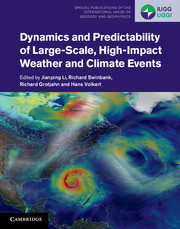Book contents
- Dynamics and Predictability of Large-Scale, High-Impact Weather and Climate Events
- Special publications of the International Union of Geodesy and Geophysics Series
- Dynamics and Predictability of Large-Scale High-Impact Weather and Climate Events
- Copyright page
- Contents
- Preface
- Frontispiece
- Book part
- Contributors
- Part I Diagnostics and prediction of high-impact weather
- Part II High-impact weather in mid latitudes
- Part III Tropical cyclones
- Part IV Heat waves and cold-air outbreaks
- Part V Ocean connections
- 20 Response of the Atlantic Ocean Circulation to North Atlantic freshwater perturbations
- 21 Key role of the Atlantic Multidecadal Oscillation in twentieth century drought and wet periods over the US Great Plains and the Sahel
- 22 Floods and droughts along the Guinea Coast in connection with the South Atlantic Dipole
- 23 The effect of global dynamical factors on the interannual variability of land-based rainfall
- 24 MJO and extreme weather/climate events
- Part VI Asian monsoons
- Index
- References
23 - The effect of global dynamical factors on the interannual variability of land-based rainfall
from Part V - Ocean connections
Published online by Cambridge University Press: 05 March 2016
- Dynamics and Predictability of Large-Scale, High-Impact Weather and Climate Events
- Special publications of the International Union of Geodesy and Geophysics Series
- Dynamics and Predictability of Large-Scale High-Impact Weather and Climate Events
- Copyright page
- Contents
- Preface
- Frontispiece
- Book part
- Contributors
- Part I Diagnostics and prediction of high-impact weather
- Part II High-impact weather in mid latitudes
- Part III Tropical cyclones
- Part IV Heat waves and cold-air outbreaks
- Part V Ocean connections
- 20 Response of the Atlantic Ocean Circulation to North Atlantic freshwater perturbations
- 21 Key role of the Atlantic Multidecadal Oscillation in twentieth century drought and wet periods over the US Great Plains and the Sahel
- 22 Floods and droughts along the Guinea Coast in connection with the South Atlantic Dipole
- 23 The effect of global dynamical factors on the interannual variability of land-based rainfall
- 24 MJO and extreme weather/climate events
- Part VI Asian monsoons
- Index
- References
- Type
- Chapter
- Information
- Publisher: Cambridge University PressPrint publication year: 2016



